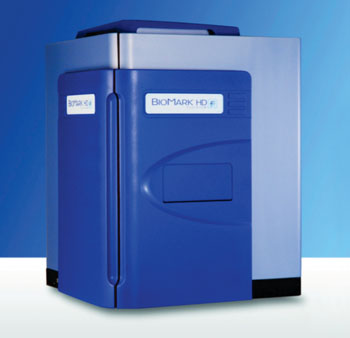Genetic and Lifestyle Factors Effect Biomarker Variation
By LabMedica International staff writers
Posted on 02 Sep 2014
Ideal biomarkers used for disease diagnosis should display deviating levels in affected individuals only and be robust to factors unrelated to the disease.Posted on 02 Sep 2014
A detailed understanding of potential confounding factors and their effect size is therefore a necessary prerequisite in the evaluation of the rapidly growing number of candidate biomarkers.

Image: The Biomark HD real-time polymerase chain reaction platform (Photo courtesy of Fluidigm).
Scientists at the Uppsala University (Sweden) analyzed 92 potential protein biomarkers for cancer and inflammation in plasma from 1,005 individuals in a longitudinal cross-sectional population-based study. The biomarkers analyzed constituted an exploration panel directed against multiple cancers and also contain proteins implicated in autoimmune diseases such as rheumatoid arthritis (RA) and Graves’ disease.
For the proximity extension assay protein levels in plasma were analyzed using the Proseek Multiplex Oncology I 96 × 96 kit (Olink Bioscience; Uppsala, Sweden) and quantified by real-time polymerase chain reaction (PCR) using the BioMark HD) real-time PCR platform (Fluidigm; South San Francisco, CA, USA). The team selected 100 individuals, for Whole-Exome Sequencing using the SureSelect system for exome capture (Agilent; Santa Clara, CA, USA) and the SOLiD 5500xl instrumentation for sequencing (Applied Biosystems; Foster City, CA, USA).
The scientists found that for 75% of the biomarkers, the levels are significantly heritable and genome-wide association studies identified 16 novel loci and replicate two previously known loci with strong effects on one or several of the biomarkers. Integrative analysis attributes as much as 56.3% of the observed variance to non-disease factors. They proposed that information on the biomarker-specific profile of major genetic, clinical and lifestyle factors should be used to establish personalized clinical cutoffs, and that this would increase the sensitivity of using biomarkers for prediction of clinical end points.
Stefan Enroth, PhD, the lead author of the study, said, “These results are important, as they show which variables are significant for variations in the measurable values. If these factors are known, we have a greater possibility of seeing variations and we get clearer breakpoints between elevated values and normal values. By extension this may lead to the possibility of using more biomarkers clinically.” The study was published on August 22, 2014, in the journal Nature Communications.
Related Links:
Uppsala University
Olink Bioscience
Fluidigm














